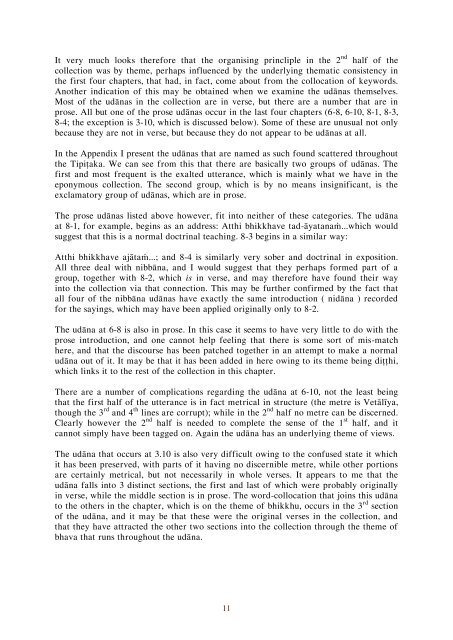Udāna, Exalted Utterances
A Pāli and English line by line (interlinear) version of this important collection of eighty discourses covering many themes and biographical details in the Buddha’s teaching (together with extensive annotation) (KN 3).
A Pāli and English line by line (interlinear) version of this important collection of eighty discourses covering many themes and biographical details in the Buddha’s teaching (together with extensive annotation) (KN 3).
Create successful ePaper yourself
Turn your PDF publications into a flip-book with our unique Google optimized e-Paper software.
It very much looks therefore that the organising princliple in the 2 nd half of the<br />
collection was by theme, perhaps influenced by the underlying thematic consistency in<br />
the first four chapters, that had, in fact, come about from the collocation of keywords.<br />
Another indication of this may be obtained when we examine the udānas themselves.<br />
Most of the udānas in the collection are in verse, but there are a number that are in<br />
prose. All but one of the prose udānas occur in the last four chapters (6-8, 6-10, 8-1, 8-3,<br />
8-4; the exception is 3-10, which is discussed below). Some of these are unusual not only<br />
because they are not in verse, but because they do not appear to be udānas at all.<br />
In the Appendix I present the udānas that are named as such found scattered throughout<br />
the Tipiṭaka. We can see from this that there are basically two groups of udānas. The<br />
first and most frequent is the exalted utterance, which is mainly what we have in the<br />
eponymous collection. The second group, which is by no means insignificant, is the<br />
exclamatory group of udānas, which are in prose.<br />
The prose udānas listed above however, fit into neither of these categories. The udāna<br />
at 8-1, for example, begins as an address: Atthi bhikkhave tad-āyatanaṁ...which would<br />
suggest that this is a normal doctrinal teaching. 8-3 begins in a similar way:<br />
Atthi bhikkhave ajātaṁ...; and 8-4 is similarly very sober and doctrinal in exposition.<br />
All three deal with nibbāna, and I would suggest that they perhaps formed part of a<br />
group, together with 8-2, which is in verse, and may therefore have found their way<br />
into the collection via that connection. This may be further confirmed by the fact that<br />
all four of the nibbāna udānas have exactly the same introduction ( nidāna ) recorded<br />
for the sayings, which may have been applied originally only to 8-2.<br />
The udāna at 6-8 is also in prose. In this case it seems to have very little to do with the<br />
prose introduction, and one cannot help feeling that there is some sort of mis-match<br />
here, and that the discourse has been patched together in an attempt to make a normal<br />
udāna out of it. It may be that it has been added in here owing to its theme being diṭṭhi,<br />
which links it to the rest of the collection in this chapter.<br />
There are a number of complications regarding the udāna at 6-10, not the least being<br />
that the first half of the utterance is in fact metrical in structure (the metre is Vetālīya,<br />
though the 3 rd and 4 th lines are corrupt); while in the 2 nd half no metre can be discerned.<br />
Clearly however the 2 nd half is needed to complete the sense of the 1 st half, and it<br />
cannot simply have been tagged on. Again the udāna has an underlying theme of views.<br />
The udāna that occurs at 3.10 is also very difficult owing to the confused state it which<br />
it has been preserved, with parts of it having no discernible metre, while other portions<br />
are certainly metrical, but not necessarily in whole verses. It appears to me that the<br />
udāna falls into 3 distinct sections, the first and last of which were probably originally<br />
in verse, while the middle section is in prose. The word-collocation that joins this udāna<br />
to the others in the chapter, which is on the theme of bhikkhu, occurs in the 3 rd section<br />
of the udāna, and it may be that these were the original verses in the collection, and<br />
that they have attracted the other two sections into the collection through the theme of<br />
bhava that runs throughout the udāna.<br />
11


















